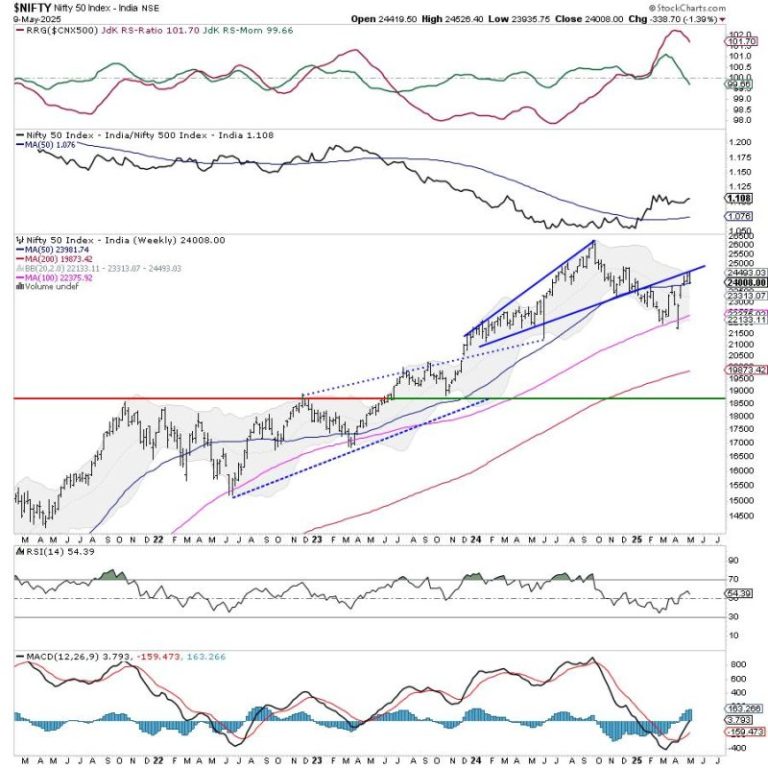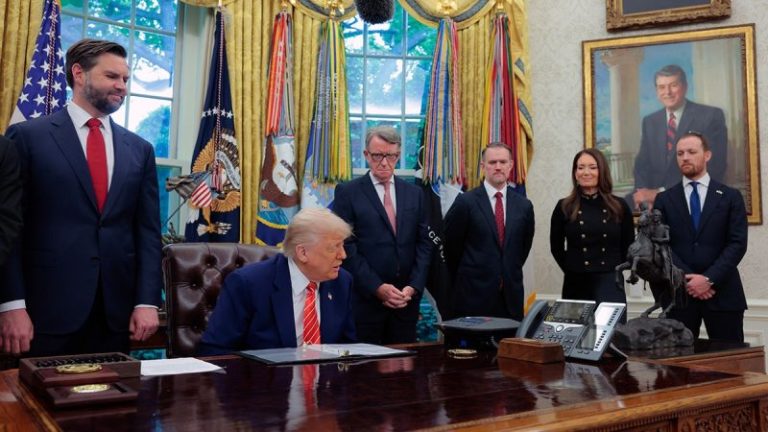The US Federal Reserve met on Tuesday (May 6) and Wednesday (May 7) for the third time in 2025. Ultimately, the committee decided to maintain its benchmark rate in the 4.25 to 4.5 percent range that was last set in November 2024.
Fed Chair Jerome Powell cited balance in the central bank’s dual mandate of price stability and maximum employment, but noted that the Trump administration’s tariffs have been more aggressive than anticipated. This was a prime factor in the Fed’s rate decision — officials are waiting for more data on how tariffs will affect inflation and employment.
On Thursday (May 8), the White House announced a trade deal with the UK. Although initial details of the deal were limited, what was provided indicates the UK will reduce or eliminate non-tariff barriers for US products and companies.
Among them are provisions for improved access to the UK market for US farmers and cattle ranchers and an increase in US ethanol exports. In exchange, the US will ease tariffs on British auto imports, with the first 100,000 vehicles being taxed at the 10 percent reciprocal rate and 25 percent on any additional vehicles.
Additionally, new negotiations will be held for an alternative arrangement to tariffs on steel and aluminum products from the UK. However, the deal does not remove the 10% reciprocal tariffs on any imports from the UK.
North of the border, Statistics Canada released its April labor force survey on Friday (May 9). The data showed little change in employment throughout the month, with just 7,500 jobs added to the workforce. Meanwhile, the employment rate declined 0.1 percent to 60.8 percent and the unemployment rate ticked up 0.2 percent to 6.9 percent.
The biggest increase of 37,000 new jobs was owed to the hiring of temporary workers related to the recent federal election. The next highest gains were in the finance, insurance and real estate sector, where 24,000 workers were added. The biggest losses were felt in manufacturing, which declined by 31,000 workers, and wholesale and retail trade, which shed 27,000 workers.
Markets and commodities react
In Canada, major indexes were mixed at the end of the week.
The S&P/TSX Composite Index (INDEXTSI:OSPTX) gained 1.46 percent during the week to close at 25,357.74 on Friday, the S&P/TSX Venture Composite Index (INDEXTSI:JX) moved up 3.57 percent to 683.4 and the CSE Composite Index (CSE:CSECOMP) falling 0.41 percent to 119.12.
US equities were flat this week, with the S&P 500 (INDEXSP:INX) flat gaining 0.08 percent to close at 5,659.90, the Nasdaq-100 (INDEXNASDAQ:NDX) gaining 0.67 percent to 20,061.45 and the Dow Jones Industrial Average (INDEXDJX:.DJI) rising 0.18 percent to 41,249.37.
The gold price strengthened in the middle of the week but remained off recent highs, but still managed to post a 2.72 percent gain, closing out Friday at US$3,328.93.
The silver price was also up, rising 2.38 percent during the period to US$32.76.
In base metals, the COMEX copper price was flat, falling just 0.64 percent over the week to US$4.66 per pound. Meanwhile, the S&P GSCI (INDEXSP:SPGSCI) rose 2.18 percent to close at 531.54.
Top Canadian mining stocks this week
How did mining stocks perform against this backdrop?
Take a look at this week’s five best-performing Canadian mining stocks below.
Stock data for this article was retrieved at 4 p.m. EDT on Friday using TradingView’s stock screener. Only companies trading on the TSX, TSXV and CSE with market capitalizations greater than C$10 million are included. Companies within the non-energy minerals and energy minerals sectors were considered.
1. Group Eleven Resources (TSXV:ZNG)
Weekly gain: 69.44 percent
Market cap: C$53.2 million
Share price: C$0.305
Group Eleven Resources is an exploration company working to advance its flagship PG West zinc, lead, copper and silver project in the Republic of Ireland. The wholly owned asset consists of 22 prospecting licenses covering 650 square kilometers and hosts the main Ballywire prospect, which was discovered in 2022.
Shares in Group Eleven gained this past week after an exploration announcement on Thursday.
The company reported assay results from four holes at Ballywire, with one highlighted copper and silver result recording grades of 1.46 percent copper and 356 grams per metric ton (g/t) silver over 19.9 meters.
It includes an intersection of 3.72 percent copper and 838 g/t silver over 6.4 meters.
It also reported an additional zinc, lead and silver hole with grades of 3.1 percent zinc, 1.4 percent lead and 22 g/t silver over 47.1 meters, which included an intersection of 7.7 percent zinc, 3.2 percent lead and 57 g/t silver over 12.9 meters.
2. Element 29 Resources (TSXV:ECU)
Weekly gain: 66.67 percent
Market cap: C$61.62 million
Share price: C$0.50
Element 29 Resources is an exploration company focused on advancing a portfolio of projects in Peru.
Its primary projects consist of the Elida copper-molybdenum-silver project in West-Central Peru and the Flor de Cobre project in the Southern Peruvian copper belt. The Elida site is composed of 29 concessions covering 19,749 hectares and hosts five distinct exploration targets within a 2.5 by 2.5 kilometer alteration system.
A September 2022 resource estimate shows an inferred resource of 321.7 million metric tons (MT) containing 2.24 billion pounds of copper at a grade of 0.32 percent, 205.7 million pounds of molybdenum at a grade of 0.03 percent and 27 million ounces of silver at 2.61 percent.
The company’s less explored Flor de Cobre project is composed of 11 mining concessions and one mining claim covering 3,135 hectares. The company announced in March that it received environmental permitting for the site and would be partnering with the GlobeTrotters Resource Group, which discovered Elida, on exploration at For de Cobre.
Shares of Element 29 posted gains this week, but the company did not share any news.
3. Giant Mining (CSE:BFG)
Weekly gain: 56.1 percent
Market cap: C$18.48 million
Share price: C$0.32
Giant Mining is an exploration company working to advance its Majuba Hill District copper, silver and gold project north of Reno, Nevada. The site consists of 403 federal lode mining claims and four private property parcels that cover an area of 3,919 hectares. Mining at the property took place between 1900 and 1950, resulting in the production of 2.8 million pounds of copper, 184,000 ounces of silver and 5,800 ounces of gold.
Extensive exploration work has been carried out at Majuba Hill, with 89,930 feet being drilled since 2007.
The most recent news from the project includes a pair of releases this week.
First, on Wednesday, the company announced that it has completed four of the five planned drill holes in its 2025 exploration program, with one of the samples sent to the lab for analysis.
The second release came on Thursday, when Giant announced that it has begun drilling the final hole of the program and expected to reach a depth of 1,000 feet. The company said the current program was designed with artificial intelligence to expand the known zones of copper mineralization and advance the project toward a mineral resource estimate.
4. PPX Mining (TSXV: PPX)
Weekly gain: 55.56 percent
Market cap: C$44.58 million
Share price: C$0.07
PPX Mining is a precious metals company that is focused on its Igor project, which contains the operating Callanquitas underground mine, located in the Otuzco province of Northern Peru.
An updated resource estimate for Callanquitas released by the company in January 2024 shows measured and indicated amounts as oxides of 81,090 ounces of gold and 2.9 million ounces of silver. The inferred resource as sulfides stands at 34,450 gold equivalent ounces at 4.63 g/t gold equivalent.
In a prefeasibility study for Igor, which was amended in January 2022, the company indicates that the 1,300 hectare site previously hosted small-scale mining operations and holds a 50 MT per day gold-processing plant from the 1980s. In November 2024, PPX announced that it had started construction of a 350 MT per day carbon-in-leach and flotation plant that will be used to process oxide and sulfide ore from Callanquitas.
The latest construction update came on March 26, when the company said major plant equipment was ready to ship from China. The equipment includes crushing plant units, metal detectors, ball mills and flotation cells. The company has not provided a further update on the timeline for when the shipments would arrive on site.
The most recent news from PPX came on Monday (May 5), when it announced that it had closed an oversubscribed non-brokered private placement. The terms of the funding will see the company issue 17.83 million shares for gross proceeds of C$802,303. Funding raised will be used for further exploration of Callanquitas and general working capital.
5. Triumph Gold (TSXV:TIG)
Weekly gain: 50 percent
Market cap: C$11.97 million
Share price: C$0.03
Triumph Gold is an explorer and developer advancing projects in the Yukon and BC, Canada.
Its three properties in the Yukon are all within the Dawson Range and consist of its flagship Freegold Mountain project, which has 20 identified mineral resources hosting gold, silver, copper, molybdenum, lead and zinc deposits; the Tad/Toro copper, gold and molybdenum project; and the Big Creek copper and gold project.
Triumph’s property in Northern BC is called Andalusite Peak.
The most recent update from the company came on Wednesday, when it announced it has refined its exploration focus on geochemical surveys and detailed geological mapping at the Andalusite Peak project, as well as defining new targets at Freegold Mountain. Additionally, the company said it has engaged Independent Trading Group to provide market-making services and enhance the liquidity of common shares.
FAQs for Canadian mining stocks
What is the difference between the TSX and TSXV?
The TSX, or Toronto Stock Exchange, is used by senior companies with larger market caps, and the TSXV, or TSX Venture Exchange, is used by smaller-cap companies. Companies listed on the TSXV can graduate to the senior exchange.
How many mining companies are listed on the TSX and TSXV?
As of February 2025, there were 1,572 companies listed on the TSXV, 905 of which were mining companies. Comparatively, the TSX was home to 1,859 companies, with 181 of those being mining companies.
Together the TSX and TSXV host around 40 percent of the world’s public mining companies.
How much does it cost to list on the TSXV?
There are a variety of different fees that companies must pay to list on the TSXV, and according to the exchange, they can vary based on the transaction’s nature and complexity. The listing fee alone will most likely cost between C$10,000 to C$70,000. Accounting and auditing fees could rack up between C$25,000 and C$100,000, while legal fees are expected to be over C$75,000 and an underwriters’ commission may hit up to 12 percent.
The exchange lists a handful of other fees and expenses companies can expect, including but not limited to security commission and transfer agency fees, investor relations costs and director and officer liability insurance.
These are all just for the initial listing, of course. There are ongoing expenses once companies are trading, such as sustaining fees and additional listing fees, plus the costs associated with filing regular reports.
How do you trade on the TSXV?
Investors can trade on the TSXV the way they would trade stocks on any exchange. This means they can use a stock broker or an individual investment account to buy and sell shares of TSXV-listed companies during the exchange’s trading hours.
Article by Dean Belder; FAQs by Lauren Kelly.
Securities Disclosure: I, Dean Belder, hold no direct investment interest in any company mentioned in this article.
Securities Disclosure: I, Lauren Kelly, hold no direct investment interest in any company mentioned in this article.
This post appeared first on investingnews.com









